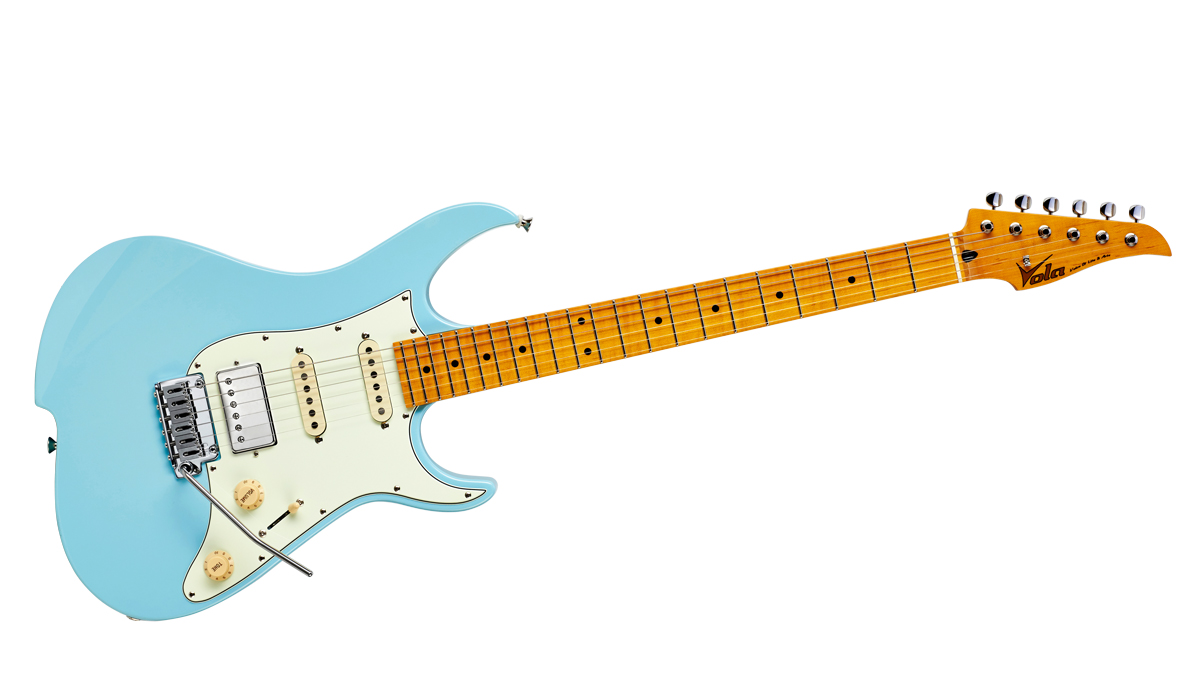MusicRadar Verdict
A pleasing riff on classic solidbody designs with a chunky neck and a clutch of classic tones.
Pros
- +
Clean design and sharp build with large palm filling neck profile.
- +
Simple sound palette with strong voices.
Cons
- -
The shape won’t appeal to everyone, neither will the big neck.
MusicRadar's got your back
Based in Hong Kong, and co-founded by Ryan Wong and Cho Shi Hyung, Vola guitars, which stands for the “voice of life and arts”, are made in Japan - there is limited USA ‘custom shop’ build, too, but those models aren’t currently available in the UK.
Along with a range that covers traditional styles, as here, Vola leans into much more modern rock creations like the Floyd Rose-equipped Ares and Blaze X.
For the most part body shapes are original and quite stylish. Here, the Oz, for example, melds an old-style Manson-type cut-out on the base with pretty conventional Ibanez-y thinner horns and the requisite altered Fender six-in-a-line headstock.
This guitar follows the classic Fender recipe. The body wood of alder is hidden under a solid colour finish. The edge radius is small and the body has a deep, but not quite vintage rib-cage cutaway. And, while there’s a scoop on the back of the treble cutaway, the body heel is old-style Fender with no chamfering or shaping.
It uses a 648mm (25.5-inch) scale length and the neck is one-piece maple with no separate fingerboard and a nicely vintage amber tint. Reflecting the more modernist style, the fingerboard radius follows a flatter Gibson-like 305mm (12-inch) camber with very tidily installed medium frets.
The neck - which has a diagonal ‘rift sawn’ grain with noticeable flame - is pretty big with a chunky ‘large C’ profile and 22 frets, the last fret seated on a fingerboard overhang. Fit and finish are superbly tidy: very typical modern Japanese build with not a hair out of place.
Also typical is the Gotoh hardware. The Oz uses the ‘modern standard’ Gotoh 510 vibrato here with a tapered die-cast FST block and steel block saddles, along with the typical collar that houses a small grub screw to tension the screw-in arm.
Want all the hottest music and gear news, reviews, deals, features and more, direct to your inbox? Sign up here.
There’s little innovation to the electronics. The Oz uses a covered (nickel-plated) humbucker at bridge with dual flat stagger single coils, a five-way lever and a master volume/master tone set-up all mounted on an adapted Strat-like shape from a three-ply, off-white plastic. The knobs and single coil covers are a slightly darker ‘coffee-d’ plastic. There’s no ID on the pickups (the body is routed to accept a neck humbucker) and the only shielding is the foil underneath all of the scratchplate; pots are 250k and the tone cap is 0.047 microfarads.
Feel and sound
Nicely weighted and with a very comfortable feel there’s encouraging resonance and clean quick attack, as you’d expect. But that’s not what’s going to make you go, “Oh!” No, that’s the relativity big, chunky neck - the Oz measures 23.3mm at the first, 25.3mm at the 12th. To put that in perspective, the depth at the first fret here is what Fender’s American Professional (and many others) measures at the 12th fret.
There’s no fingerboard edge rounding, you’ll have to wear it in yourself, and the gloss poly finish, once the go-to for every manufacturer, begins to feel rather marginalised as so many makers employ satin, oiled wood, or simply worn ‘aged’ neck finishes. That said, it seems to be a light finish to the neck with very little, if any, build-up around the frets.
Broadly speaking there’s not much you haven’t heard here before. The Oz is a smart, bright (not overly), zinging Strat-alike with some extra rock sauce in bridge. The middle pickup is probably reverse-wound with reverse polarity as we have hum-cancelling in the mix positions - the bridge and middle mix position also splits the humbucker to voice its screw single coil. There’s a good balance between the singles and the ’bucker too: yes, there’s a little lift but it’s not a huge jump, and with rock and Texas blues tones, the neck single coil almost matches the bridge’s authority.
There’s nothing here that’s going to change the world but it is a nicely dialled-in guitar - although you’ll need to tilt the Oz’s vibrato to get any upbend. Tuning stability is as good as you are at fixing your strings, stretching them and making sure the nut’s grooves are smooth (which they are).
If you’ve been around guitars for any length of time you’ll no doubt appreciate Japanese craft. Okay, that might be a huge generalisation but we can’t remember moaning about Japanese build-quality for many, many a year - if ever. So like Ibanez’s Prestige or John Page’s Classics, this Vola ticks the quality box and then some.
This guitar certainly uses the time honoured Fender blend but at least Vola has given it a different aesthetic - which may or may not, of course, be a good thing. We can’t predict your taste but, shape aside, if you like classic Fender-style with a nicely meaty and big ol’ neck this is a perfectly weighted, comfortable guitar with reasonable colour choices and the sort of sounds the style and price suggest.
Dave Burrluck is one of the world’s most experienced guitar journalists, who started writing back in the '80s for International Musician and Recording World, co-founded The Guitar Magazine and has been the Gear Reviews Editor of Guitarist magazine for the past two decades. Along the way, Dave has been the sole author of The PRS Guitar Book and The Player's Guide to Guitar Maintenance as well as contributing to numerous other books on the electric guitar. Dave is an active gigging and recording musician and still finds time to make, repair and mod guitars, not least for Guitarist’s The Mod Squad.

